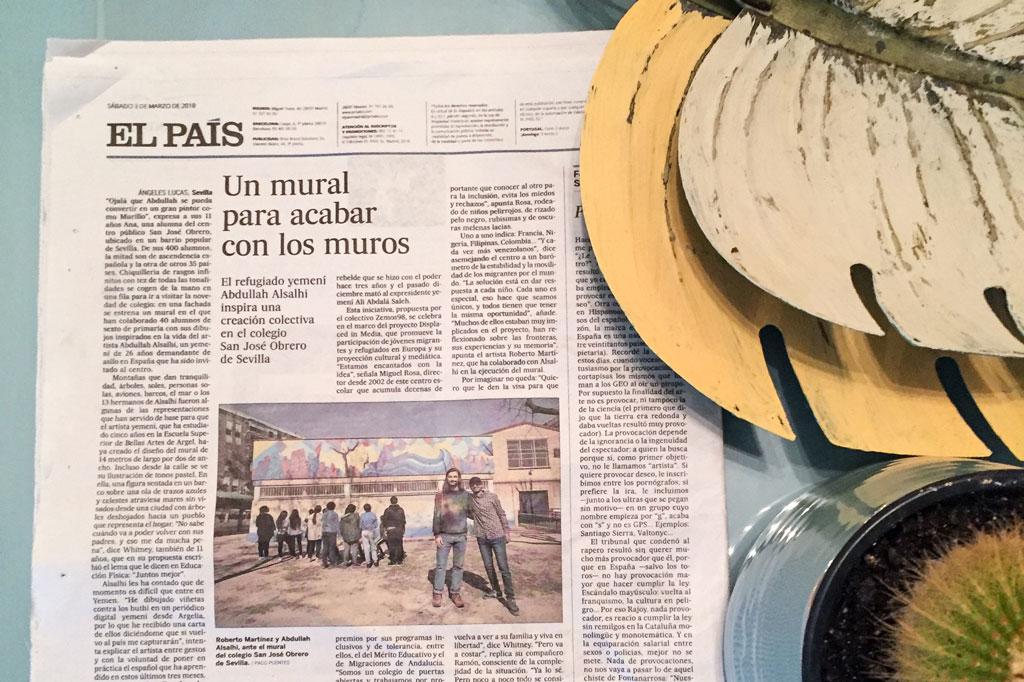
A wall to end all walls
“I hope that Abdullah becomes as great a painter as Murillo”, Ana, 11, a student at San José Obrero primary school. Only half of the students here have Spanish roots, the other half come from 35 different countries across the world. Children from all over line up to visit the school’s new creation: a mural 14 metres long that can even be seen from the road. 40 students from Year 6 have worked together to create a mural inspired by the life of Abdullah Alsalhi, a 26 year old yemeni asylum seeker, who studied at the School of Fine Arts in Algiers for 5 years.
The mural depicts a woman in a boat, travelling without a visa from a city with bare trees to a town that represents her home. “She doesn’t know when she’s going to see her parents again and this makes me really sad”, says Whitney, also 11. Alsalhi doesn’t know when he can return to Yemen: “When I was in Algeria I drew a cartoon against the Houthi that was published in an online paper, I got a letter saying that if I return to my country they’d capture me”. He explains this through gestures and the Spanish that he’s learned since he entered the country 3 months ago to ask for asylum. “I can’t go back, I’ve got problems with military groups”, the artist says about the Houthi, a rebel faction that took power 3 years ago and killed the ex-president Ali Abdalá Saleh in December 2017.
This initiative, proposed by ZEMOS98, is part of Displaced in Media, a project that promotes participation by young migrants and refugees in European society, with the objective of including their voices, desires and hopes in media discourse and the public sphere.
“We’re delighted with it”, says Miguel Rosa, headteacher of the school that has won multiple prizes for its inclusive programmes: “We’re an open door school and we work through projects.” He lists the birthplaces of some the students: France, Nigeria, Philipines, Colombia… and increasing numbers from Venezuela. Artist Roberto Martinez, who worked with Alsalhi on the mural, adds “Each child is special, this is what makes us unique. Everybody has to have the same opportunities. Many of the children were really involved in the project; they reflected on borders, their experiences and their memories”.
“I want them to give him the visa so he can go and see his family and live in freedom”, says Whitney. “But it’s going to be difficult”, replies Ramón, who’s conscious of the complexity of the situation. “I know. But bit by bit he’ll get it”. She answers. Ramón writes on his drawing “War always brings problems”.
400 students – half spanish, half 35 other countries.
40 year 6 students worked together to create a mural inspired by the life of Abdullah Alsalhi, 26 year old yemeni asylum seeker.
Mountains, trees, sun, solitary people, planes, boats, the sea, Abdullah’s 13 brothers – all some of the things that inspired him (studied 5 years in school Bellas Artes in Algiers) for the mural 14 x 2m that can even be seen from the road.
Drawing consists of a women sitting in a boat on a wave of blue and light blue slices crossing seas without a visa from a city with leafless trees to a town that represents home “she doesn’t know when she’s going to be able to be with her parents again and this makes me really sad. Together is better” – Whitney, 11.
Alsalhi has told them that at the moment it’s difficult for him to go to Yemen: “I drew a cartoon against the Houthi in an online paper when I was in Algeria, and got a letter from them saying that if I return to my country they’d capture me” – he tries to explain with gestures and using the Spanish that he’s learnt in the last 3 months since he entered Spain and asked for asylum. “I can’t go back, I’ve got problems with war groups”, the artist says about the Houthi, a rebel faction that took power 3 years ago and last December killed the ex-president Ali Abdalá Saleh.
This initiative, proposed by Zemos98, is celebrated as part of the project Displaced in Media, that promotes the participation of young migrants and refugees in Europe and its cultural and media projections.
“We love the idea”, Miguel Rosa, director since 2002 of the school that has won tens of prizes for its inclusive programmes about tolerance, such as the Mérito Educativo and the Migraciones de Andalucia. “We’re a school with open doors and we work with projects. Our philosophy is to place less importance on the contents/restraints and more on emotional nature and emotions. There is nothing more important than knowing to promote inclusion and avoid fear and rejection”, he says, surrounded by children with red curly hair and dark faces, very blonde and straight dark hair.
One by one he says: France, Nigeria, Philipines, Colombia… “and each time more Venezuelans”, mirroring the center with a barometer of stability and movement of migrants across the world. “The solution is in satisfying the needs of each child. Each one is special, this is what makes us unique, and everybody has to have the same opportunities. Many of them were really involved in the project, they reflected on borders, their experiences and their memory” adds the artist Roberto Martinez, who worked with Alsalhi in the execution of the mural.
“I want them to give him the visa so he can go and see his family and live in freedom”, says Whitney. “But it’s going to be difficult”, replies Ramón, who’s conscious of the complexity of the situation. “I know. But bit by bit he’ll get it, with calmness and patience” she replies. The boy writes in his drawing “War always brings problems”.
Artículo traducido por Rosa Cagnoni, del original publicado en El Pais, escrito por Ángeles Lucas.




No Comments